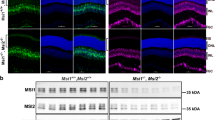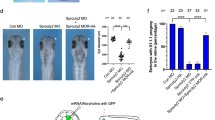Abstract
CELL-FATE specification of R7 photoreceptors in the developing Drosophila eye depends on an inductive signal from neighbouring R8 cells. Mutations in three genes, sevenless (sev), bride-of-sevenless (boss) and seven-in-absentia (sina) cause the R7 precursor to become a non-neural cone cell1–3. The sev gene encodes a receptor protein tyrosine kinase (Sev) localized on the R7 surface, activated by a boss-encoded ligand presented by R8 (refs 4–6). The sina gene encodes a nuclear factor required in R7 (ref. 3). Reduction in the dosage of the Rasl gene impairs Sev-mediated signalling, suggesting that activation of Rasl may be an important consequence of Sev activation7. We report here that Rasl activation may account for all of the signalling action of Sev; an activated RaslVal12 protein rescues the normal R7 precursor from transformation into a cone cell in sev and boss null mutants and induces the formation of supernumerary R7 cells. Similar activation of the Drosophila Ras2 protein does not produce these effects, demonstrating Ras protein specificity.
This is a preview of subscription content, access via your institution
Access options
Subscribe to this journal
Receive 51 print issues and online access
$199.00 per year
only $3.90 per issue
Buy this article
- Purchase on Springer Link
- Instant access to full article PDF
Prices may be subject to local taxes which are calculated during checkout
Similar content being viewed by others
References
Tomlinson, A. & Ready, D. F. Devl Biol. 123, 264–275 (1987).
Reinke, R. & Zipursky, S. L. Cell 55, 321–330 (1988).
Carthew, R. W. & Rubin, G. M. Cell 63, 561–577 (1990).
Hafen, E., Basler, K., Edstroem, J.-E. & Rubin, G. M. Science 236, 55–63 (1987).
Tomlinson, A., Bowtell, D. D. L., Hafen, E. & Rubin, G. M. Cell 51, 143–150 (1987).
Krämer, H., Cagan, R. L. & Zipursky, S. L. Nature 352, 207–212 (1991).
Simon, M. A., Bowtell, D. D. L., Dodson, G. S., Laverty, T. R. & Rubin, G. M. Cell 67, 701–716 (1991).
Bowtell, D. D. L., Kimmel, B. E., Simon, M. A. & Rubin, G. M. Proc. natn. Acad. Sci. U.S.A. 86, 6245–6249 (1989).
Van Vactor, D. L. Jr, Cagan, R. L., Krämer, H. & Zipursky, S. L. Cell 67, 1145–1155 (1991).
Basler, K., Christen, B. & Hafen, E. Cell 64, 1069–1081 (1991).
Seeburg, P. H., Colby, W. W., Capon, D. J., Goeddel, D. V. & Levinson, A. D. Nature 312, 71–75 (1984).
Fortini, M. E. & Rubin, G. M. Genes Dev. 4, 444–463 (1990).
Bier, E., Ackerman, L., Barbel, S., Jan, L. & Jan, Y. N. Science 240, 913–916 (1988).
Robinow, S. & White, K. J. Neurobiol. 22, 443–461 (1991).
Mozer, B., Marlor, R., Parkhurst, S. & Corces, V. Molec. cell. Biol. 5, 885–889 (1985).
Brock, H. W. Gene 51, 129–137 (1987).
Bishop, J. G. III & Corces, V. G. Genes Dev. 2, 567–577 (1988).
Hall, A. Science 249, 635–640 (1990).
Aroian, R. V., Koga, M., Mendel, J. E., Ohshima, Y. & Sternberg, P. W. Nature, 348, 693–699 (1990).
Han, M. & Sternberg, P. W. Cell 63, 921–931 (1990).
Beitel, G. J., Clark, S. G. & Horwitz, H. R. Nature 348, 503–509 (1990).
Yarden, Y. & Ullrich, A. A. Rev. Biochem. 57, 443–478 (1988).
Cantley, L. C. et al. Cell 64, 281–302 (1991).
Ullrich, A. & Schlessinger, J. Cell 61, 203–212 (1990).
Cross, M. & Dexter, T. M. Cell 64, 271–280 (1991).
Bowtell, D. D. L., Lila, T., Michael, W. M., Hackett, D. & Rubin, G. M. Proc. natn. Acad. Sci. U.S.A. 88, 6853–6857 (1991).
Bowtell, D. D. L., Simon, M. A. & Rubin, G. M. Genes Dev. 2, 620–634 (1988).
Maniatis, T., Fritsch, E. F. & Sambrook, J. Molecular Cloning: A Laboratory Manual (Cold Spring Harbor Laboratory Press, New York, 1982).
Rubin, G. M. & Spradling, A. C. Science 218, 348–353 (1982).
Kimmel, B. E., Heberlein, U. & Rubin, G. M. Genes Dev. 4, 712–727 (1990).
Dietrich, W. Z. Wiss. Zool. 92, 465–539 (1909).
Author information
Authors and Affiliations
Rights and permissions
About this article
Cite this article
Fortini, M., Simon, M. & Rubin, G. Signalling by the sevenless protein tyrosine kinase is mimicked by Rasl activation. Nature 355, 559–561 (1992). https://doi.org/10.1038/355559a0
Received:
Accepted:
Issue Date:
DOI: https://doi.org/10.1038/355559a0
This article is cited by
-
Siah2 integrates mitogenic and extracellular matrix signals linking neuronal progenitor ciliogenesis with germinal zone occupancy
Nature Communications (2020)
-
Phylogenetic analysis of the SINA/SIAH ubiquitin E3 ligase family in Metazoa
BMC Evolutionary Biology (2017)
-
Sexually dimorphic gene expression in the lateral eyes of Euphilomedes carcharodonta (Ostracoda, Pancrustacea)
EvoDevo (2015)
-
Paratransgenesis: a promising new strategy for mosquito vector control
Parasites & Vectors (2015)
-
Cell competition may function either as tumour-suppressing or as tumour-stimulating factor in Drosophila
Oncogene (2014)
Comments
By submitting a comment you agree to abide by our Terms and Community Guidelines. If you find something abusive or that does not comply with our terms or guidelines please flag it as inappropriate.



